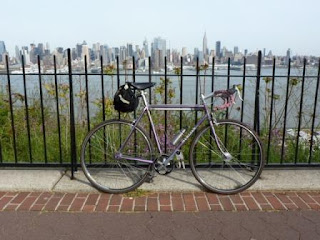 |
| On Le Col du Lauteret during Le Tour de France, 1930 |
At the New Amsterdam Bike Show, I bumped into someone who works at a bike shop I've mentioned on this blog. As it happens, this person and I share similar tastes in bikes and attitudes toward riding.
He recently fixed up a vintage frame with components that were mostly from the same period as the frame. After taking it out for a ride, he said there was something he simply could not understand: "How did you climb hills with a 13-21 cluster?"
Back in the day, we didn't use cassettes that mounted on cog carriers on our rear wheels. They weren't available. Instead, we used freewheels that threaded onto the hub itself. We usually referred to the cogs that were on the freewheel as a "cluster." So, a "13-21 cluster" meant that the largest gear had 21 teeth and the smallest, 13.
 |
| SunTour "Winner" freewheel: one of the best of its era |
The ratio I just mentioned was the one most commonly used by racers. Usually, we rode them with front chainrings of 42 and 52 or 53 (or, sometimes, 54) teeth. To compare, consider that most racers today are riding 12-23 or 12-25 cassettes with 39-53 in the front.
(Experienced cyclists know that in the rear, a smaller sprocket means a higher gear, but a lower gear on the front.)
 |
| "Sawtooth" pedals, a.k.a. Campagnolo Pista con denti |
I was going to tell me young friend that, yes, we were tougher in those days before video games, i-Phones and such. Yes, indeed, I would have told him that we pedaled--with our bare feet on "sawtooth" pedals--100 miles through the snow every day to get to our training rides. But my young friend is, of course, intelligent enough not to believe anything like that. Besides, it's one thing for a middle-aged man who weighs about forty pounds more than he did in his racing days to say such things. For a middle-aged woman to say it really would have stretched the limits of his credulity. What I'm really saying in the previous sentence is that I would have simply felt silly telling a story like that.
Anyway, I ventured a few explanations for him. For one thing, I said, we didn't know as much about cycling injuries in those days, so many of us pedaled and pedaled--in high gears--until we blew out our knees or hurt ourselves in other ways. We thought we could "pedal through" whatever ailed us. Plus, the prevailing wisdom of the day stressed power rather than a high rate of RPMs.
Also, I said, bikes and gearing were different. Eddy Mercx won five Tours with only five gears in his rear cluster. So, he was riding with ten speeds--in total. Today, "ten speed" refers to the number of gears (sprockets) in the rear cassette of a typical (Shimano-equipped) racing bike.
What that meant was that the jumps or gaps between gears was much greater on five-speed clusters than it is on ten-speed cassettes with the same range of gears. That is the reason why the smallest gears were bigger (typically 13 or 14 vs. today's 12 or 11) and the largest were smaller (19, 20 or 21 vs. 23, 24, 25 or even 26) than what's found on racing bikes today.
Back in those days, tourists rode clusters on which the smallest sprocket had 14 teeth and the largest comprised 28, 32, 34 or even 36 teeth. You can see that on a five- (or even six- or seven-) speed cluster, the gaps between gears would be enormous. Some tourists would overcome that somewhat by having two closely-spaced sprockets (chainrings), along with one that was much smaller (the "granny" gear) in the front. However, racers and others who ride a lot of training miles prefer smaller differences between gears because those differences are more noticeable on a lightweight bike that's not loaded down with panniers full of clothing and camping equipment.
 |
| "Corncob" freewheel. Yes, I rode this very freewheel, and others like it! |
In other words, we were riding those small ("corncob") clusters because of the quirks in the equipment that was available to us, as well as our relative ignorance about cycling injuries. And, in my case, I had something (besides a few thousand fewer fat cells) in my body that I don't have now: testosterone. Of course, my young friend still has that. So he has no excuse. (Ha, ha!)








.jpg)

























